Making a faux wood grain table top is easier than you think using this simple paint technique. No stripping or staining is required - in fact, this look is achieved with chalk paint and antiquing wax.
In this How To Paint Furniture To Look Like Wood in 3 Simple Steps post I walk you through this easy fake wood paint technique!


Content may contain affiliate links. When you shop the links, we receive a small commission at no cost to you. Thanks for supporting my small business.
This soft faux wood finish added just enough warmth in my white living room styling.
Jump to:
- About this painting technique
- Why you will love this technique
- 3 Steps to a beautiful finish
- Step by step instructions
- Using this technique on laminate furniture
- Frequently asked questions
- Variations and other considerations
- Other projects I've done using this technique
- More furniture refinishing inspiration
About this painting technique
I first learned of this technique a couple of years ago and originally tried it on an old vintage end table that I picked up from the Facebook Marketplace. It was such a simple technique and 4 years later, the table still looks like the day I finished it. This table featured above sits on the end of our sofa and fits perfectly in this space. There are no scratches or stains and it has held up really well. The best part is that you would never know the top is a faux wood grain painting technique.

Pictured is a dining room table with this simple fake wood paint technique.
Why you will love this technique
- Ease: No sanding, no priming (unless you want to and unless your painting over laminate - more on that below!) for this simple fake wood paint technique. Chalk paint is a breeze to work with however Valspar Antiquing Wax is the hero here! This antiquing wax goes on so smoothly and gives you plenty of time to get your finished look just right before drying and stay right in place! Doesn't get better than that!
- Cost: Grab an inexpensive piece of furniture at your local thrift shop or on Facebook Marketplace and give it a completely new look for a fraction of the cost of new furniture using this technique.
- Look: Let's face it, wood grain is timeless! One of the things I love about this technique is its faux wood grain with an artsy twist. From afar you wouldn't know that the furniture isn't real stained wood but up close you can see that it's a hand-painted piece of art and a one-of-a-kind piece.
3 Steps to a beautiful finish
Want to transform your furniture with a beautiful faux wood finish? It's easier than you think! Here's a quick overview of this straightforward process:
1. Chalk Paint Your Piece
Prep your furniture by ensuring it's clean. With chalk paint, minimal prep is needed; however, for darker or older pieces, apply 2 coats of B-I-N Shellac Primer first, let it dry, lightly sand, then proceed with chalk paint. Chalk paint typically requires 2-3 coats, but it dries fast, making the process efficient.(for more details about painting older dark pieces using B-I-N Shellac Primer to block bleed through, check out my Antique Mirror Makeover post where I walk through the entire process.)

2. Antiquing Wax for a Wood Grain Look
Once dry, tape off areas you want to avoid waxing. Stir Valspar Antiquing Wax thoroughly. Unlike traditional wax, this product behaves more like a gel wood stain. Apply it with a chip brush, ensuring brush strokes go in the same direction for a faux wood grain effect. Use a lint-free cloth to smooth the finish if desired. Apply multiple coats, allowing each to dry for about 2 hours, until achieving the desired darkness.

3. Sealing Your Piece with Polycrylic
After the faux wood grain finish has dried overnight, apply a top coat of polyurethane to protect the finish. Let it dry completely. Finally, complete the look by adding new drawer knobs if desired.

Now, let's dive into each step in more detail!
Step by step instructions
Supplies for this project
- Piece of furniture of your choice
- Can of white chalk paint (enough to cover the furniture piece)
- Can of Valspar Antiquing Wax
- Minwax Polycrylic clear satin polyurethane
- Chip Paint brushes
- Chalk paint brush
- Frog tape -painters tape
- B-I-N Shellac Primer (for older dark stained pieces)
- Chalk paint your piece
Prep your furniture piece by ensuring it's clean. With chalk paint, minimal prep is needed; however, for darker or older pieces, apply 2 coats of B-I-N Shellac Primer first, let it dry, lightly sand, then proceed with chalk paint. Chalk paint typically requires 2-3 coats, but it dries fast, making the process efficient. (check out special instructions for laminate pieces below)

- Antiquing wax for a wood grain look
Once dry, tape off areas you want to avoid waxing. Stir Valspar Antiquing Wax thoroughly. Unlike traditional wax, this product behaves more like a gel wood stain. Apply it with a chip brush, ensuring brush strokes go in the same direction for a faux wood grain effect. Use a lint-free cloth to smooth the finish if desired. Apply multiple coats, allowing each to dry for about 2 hours, until achieving the desired darkness.

- Sealing your piece with Polycrylic
After the faux wood grain finish has dried overnight, apply a top coat of polyurethane to protect the finish. Let it dry completely. Finally, complete the look by adding new drawer knobs if desired.

Using this technique on laminate furniture
When applying the wood-like paint technique to laminate furniture, it's crucial to acknowledge the unique surface of laminate, which often resists paint adhesion due to its sleek finish. To overcome this challenge, a high-quality bonding primer is essential. I recommend using Benjamin Moore Stix Primer for bonding, as it creates a strong foundation for the chalk paint to adhere to, ensuring a durable and long-lasting finish. The bonding primer acts as a bridge between the laminate surface and the paint, promoting better adhesion and preventing peeling or chipping over time. With the right primer, you can achieve the wood-like look on laminate furniture with confidence, knowing that your finish will stand the test of time.
Frequently asked questions
The best paint for this project is chalk paint due to its grit and ability to adhere to various surfaces. Having said that, you can try other types of paint ( oil-based paint, mineral paint, etc) as the base coat. In fact, for our outdoor table (featured below) I used exterior latex paint, and that type of paint worked really well under the antiquing wax.
Yes! To ensure your paint adheres properly you could use a bonding primer like Benjamin Moore Stix Primer before moving onto apply the chalk paint base.
As long as the furniture piece is in good condition, you do not need to sand it.
Any old furniture you want to have a faux wood look. This fake wood paint technique works great on wooden furniture as well as laminate furniture. You can find great pieces at a thrift store, antique market or Facebook Marketplace. This finish would look beautiful on a kitchen table, coffee table, end table or dining table.
Variations and other considerations
Other base paint colors: I think about this a lot - probably more than I should! The base paint color for the end tables above is white so when you use the dry brush the white paint is what shows through. This "under" color impacts the outcome greatly. You can use soft yellows or oranges like the outdoor table below for a warmer, more blond wood tone. For a cooler finish consider using gray.
Sample boards: If this is your first time using this fake wood paint technique or you are using a color you haven't used before I highly suggest you make a sample board. Grab a spare piece of wood and paint it the base coat followed by the antiquing wax. This way you will know exactly what to expect. You can also determine if you like the texture of the brush strokes or if you want a smoother more blended finish using a rag.
Distressing techniques: Chalk paint and distressing go hand in hand. You may want to take a light to medium grit sandpaper to the legs of your table to give it some character. For more information on distressing visit my best paint for distressing furniture post, I share tips on how to distress furniture including 4 different distressing techniques.
Tip: To learn more about distressing furniture visit my, How to Distress Chalk Paint Furniture: The Only Technique You Need post!
Other projects I've done using this technique
Outdoor table
I used this technique to refinish an outdoor table that we got on FB Marketplace last summer. This thick sturdy table with matching benches was a steal at just $200. We placed it in our outdoor under-deck space to create an outdoor dining space. I loved the black legs but wanted to try my hand at a faux wood finish top. Below is my real wood inspiration (left) and the results of my DIY wood-look table top (right).
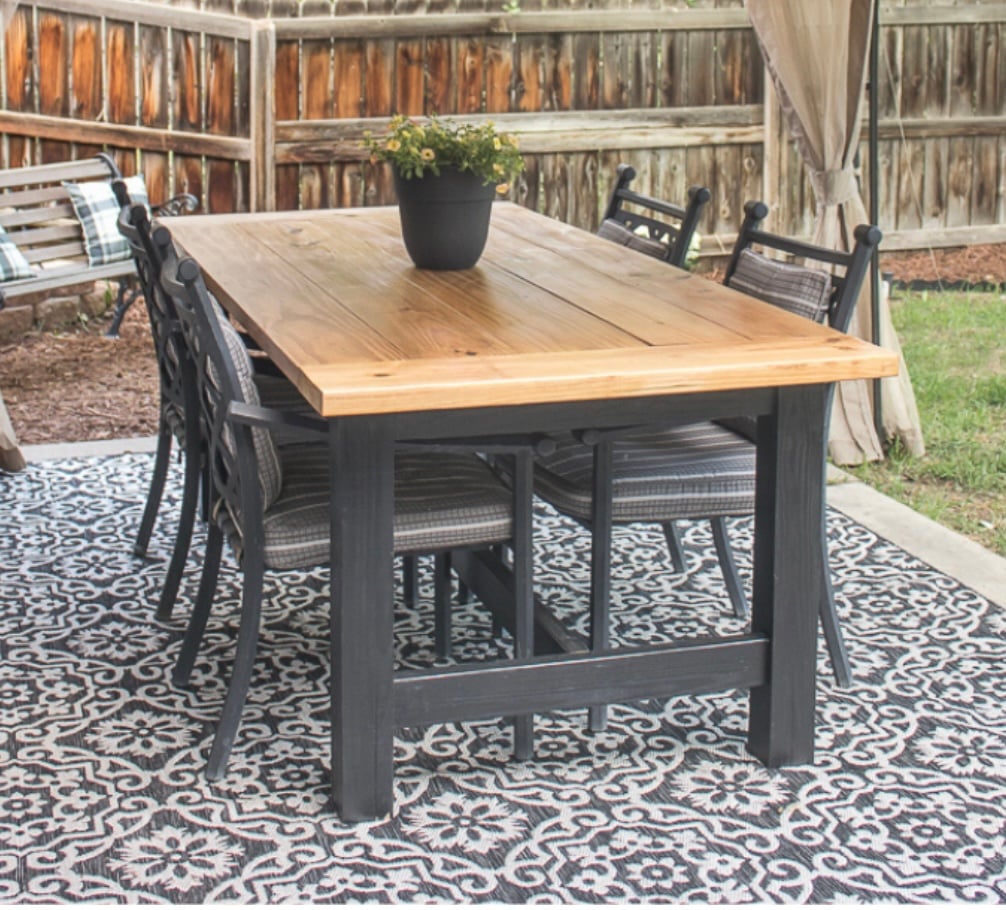

For this table, I first painted it with Benjamin Moore exterior latex paint in Seagull gray to match the color of our home. I then went in with a more orangey exterior latex because I was hoping to match some natural rattan chairs we have (seen in the background near our DY paver fire pit in the photo above). The plan was to have the wood-like finish be warm. I used a wood grain tool on this table. I simply rolled on the orange-tone paint and dragged the tool through stopping and rolling to create faux knots on the table. The result was....well awful! But I wasn't done yet! Valspar antiquing wax to the rescue! Here's before Valspar saved the day!
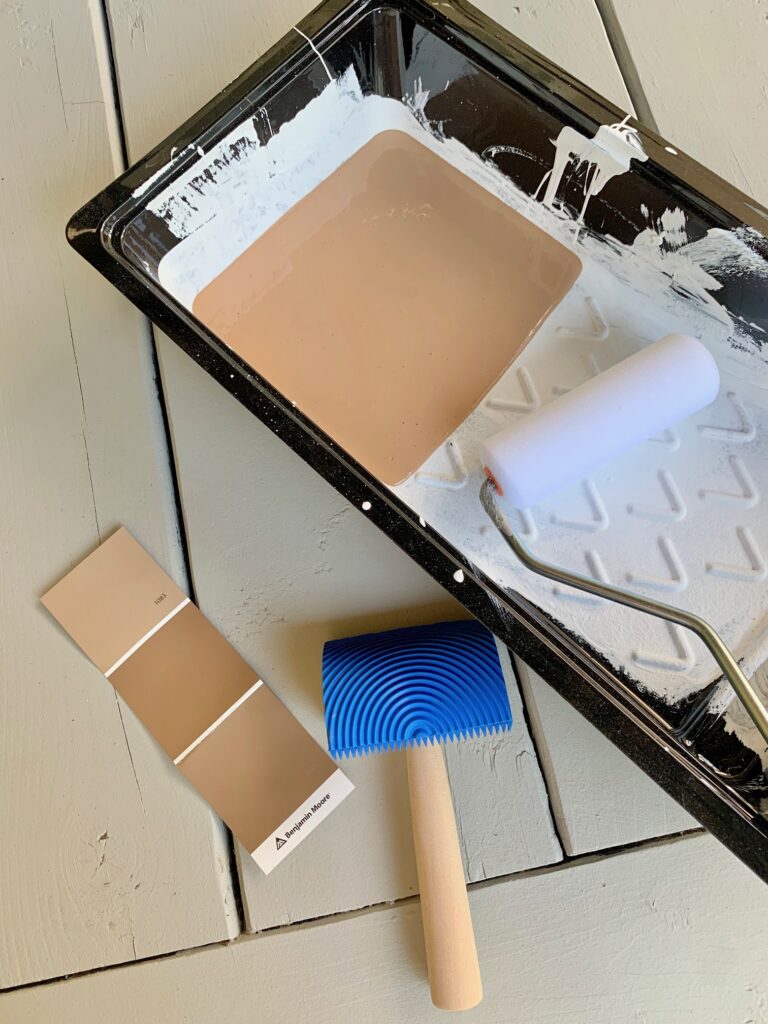


The finish before the Valspar was super choppy and the colors together looked terrible. I knew going in that by using Valspar antiquing wax for the top coat I would have a more blended look that would closely resemble my real wood inspiration table. For this application, I took a t-shirt rag and rubbed the antiquing wax onto the table and finally my vision came to life!
Thoughts on the Wood Graining Tool: I thought I would like the wood grain tool more than I did. I found the pattern to be too big and prefer the more blended look of a dry paintbrush. (Note: I linked similar as the exact one I used is currently unavailable)
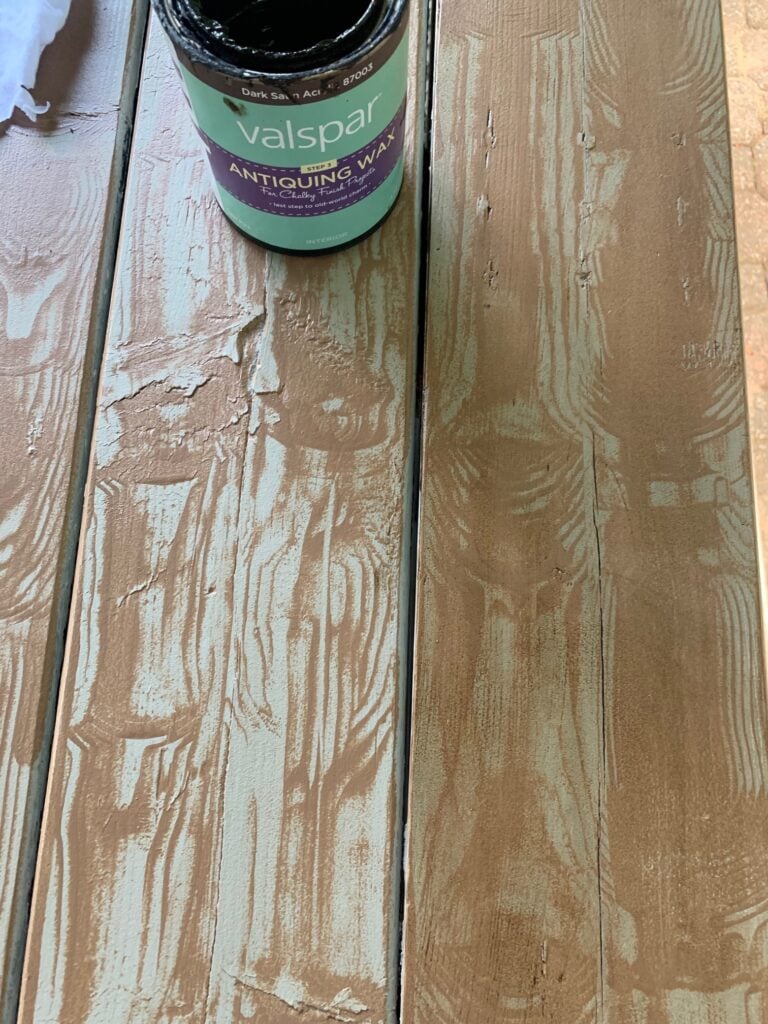


I sealed this table with outdoor clear decking sealer since this table is somewhat open to the elements here in Massachusetts. I've had a lot of questions about the antiquing waxing holding up in the heat. Due to the fact that it resembles more of a gel stain than wax, I have had zero problems with it in the heat.

You can see more views of this table in this Simple Fall DIY Dining Table Centerpiece Idea post. Here is a photo of the table in our outdoor dining space.

Dining table makeover
I also used this same technique with a dining table that I refinished for my booth. I used Fusion mineral paint in this beautiful green color (Bayberry) for the skirt and the legs, white chalk paint as the base coat on the table top, and then Valspar antiquing wax to create the faux wood table top. For this project, I used a lint-free rag instead of a brush to give it a more blended finish.


Console table
I refinished this entryway table using the same technique as the original project. Did mention this look sells well at my vintage booth? This table was a Facebook marketplace find for $25. The legs are painted using cream-colored chalk paint and the top is my 3-step process for a wood-like finish.
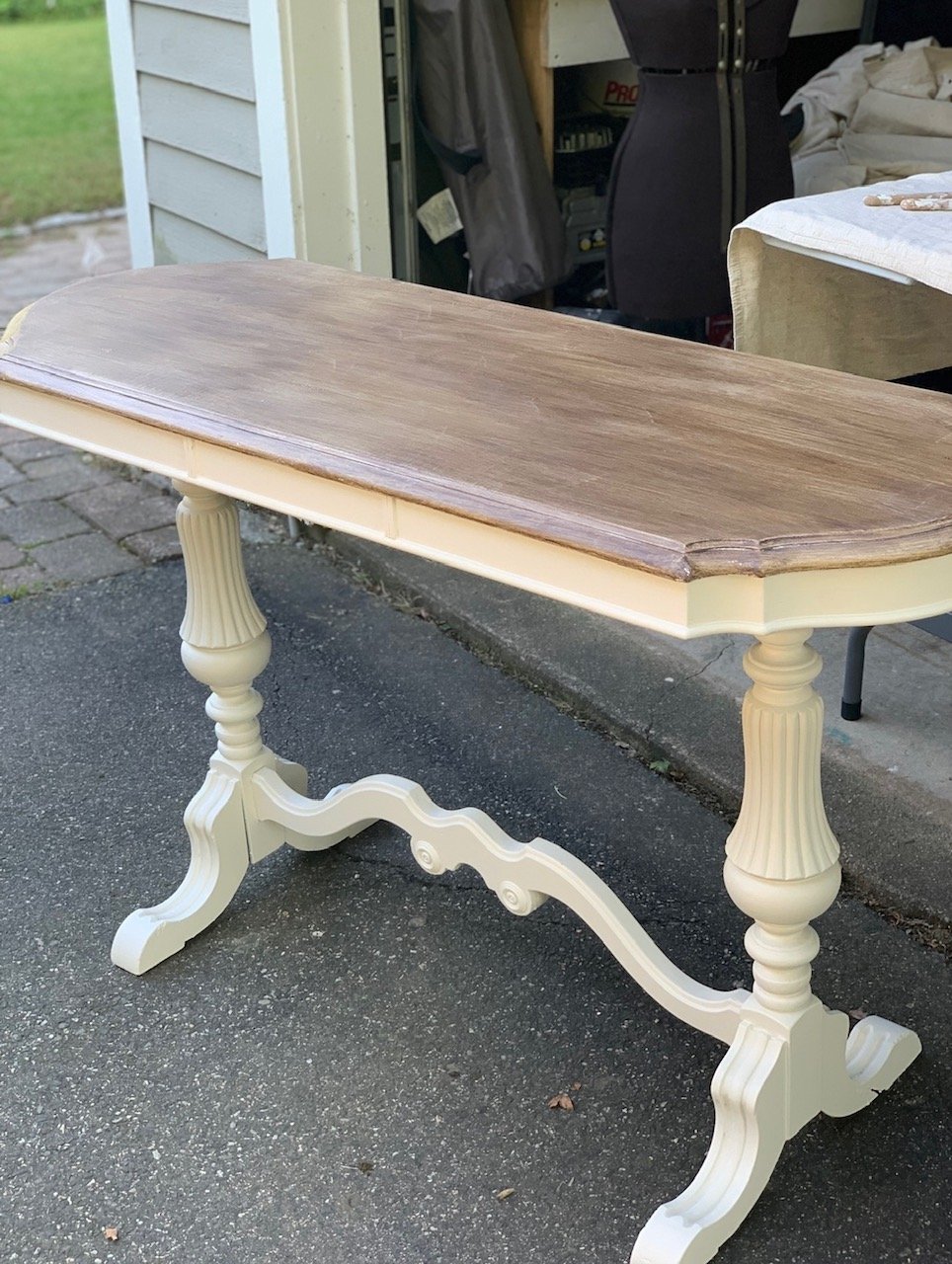
Night stands for our guest bedroom
Lastly, this application was perfect for night stands that we put in our guest bedroom retreat. We did this whole room on a budget, with these tables coming from Facebook Marketplace at only $40 for the pair. Thanks to this simple technique, I now have beautiful tables that look like they cost much more than what we invested in them.
You'll notice that this finish appears much lighter than the others. I used the same process but applied a more thorough wipe-down of the Valspar wax, leaving just a hint of color on the surface.

More furniture refinishing inspiration
Looking for more furniture transformation ideas? Explore our collection of refinishing projects:
- Discover the best black furniture paint options for creating dramatic, sophisticated furniture with our tested recommendations
- Master the techniques for achieving a flawless white finish that resists yellowing and prevents bleed-through
- See how a vintage card catalogue becomes a showstopping accent piece with custom green paint and creative hardware choices
- Learn how to reimagine an outdated hutch as an elegant DIY linen cabinet that combines beauty with practical bathroom storage
These creative furniture makeovers will inspire your next DIY project while providing practical techniques to achieve professional-quality results on any budget.
I love DIY projects that take an entire piece of furniture and give it new life! This finish is so easy to achieve and Valspar antiquing wax is the way to go when looking for a faux wood finish.
Thanks for visiting the blog today. I loved sharing How To Paint Furniture To Look Like Wood in 3 Simple Steps with you! For more fun DIY projects be sure to check out my furniture refinishing projects including this adorable DIY dog bed!
Keep creating friends!
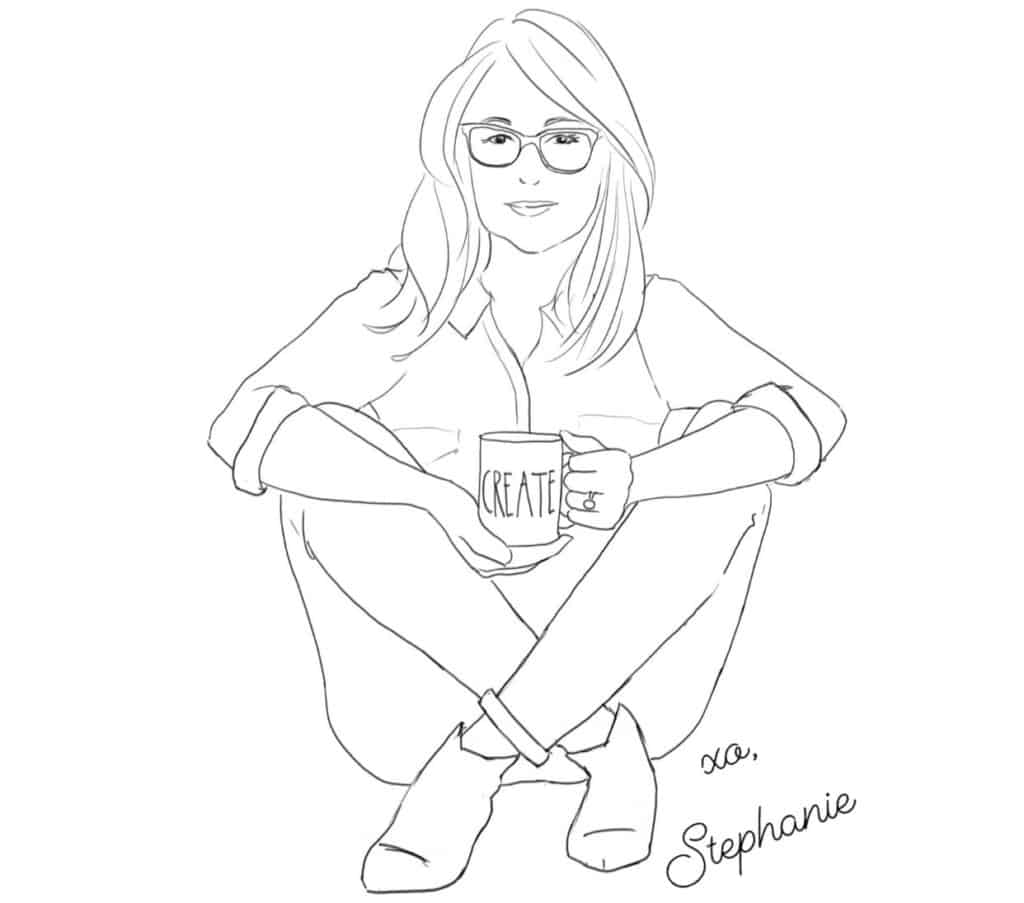

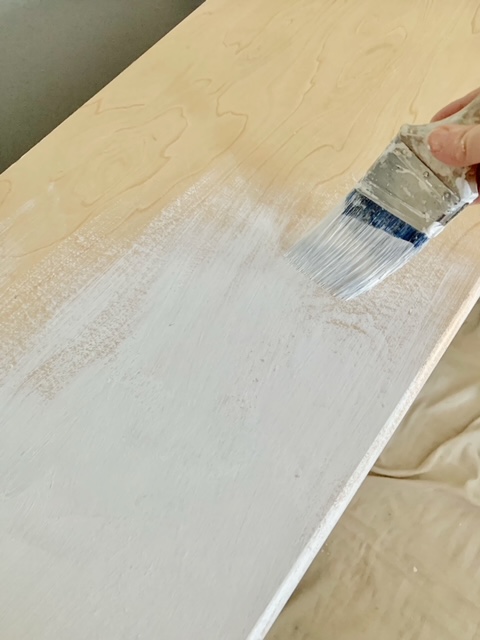








Hello stephanie I am roro from danmark I want a help to give my white smoothy dinning table a faux wood look with high protection ,so what I need to do and save in money as possible
Hi Roro, If your dining room table is already white you are half way there! I would suggest getting the Valspar antiquing wax and follow the instructions in the blog post to apply. For a dining room table I would suggest two coats of polycryllic. Be sure to let the polycrylic dry completely between coats and let it cure (per instructions on the can) before use.
Is the antiquing wax the same as finishing wax. I keep reading you can't apply polcrylic over wax.
Thanks!
Hi Brenda, I don't believe it is. The antiquing wax is quite unique in that it does not feel or apply like wax (despite its name!). It's more of a gel than a wax. I have done this application a number of times with poly and the finish is beautiful and durable! Hope this helps!
What do you use to put the polycrillic on?
Hi Beth, So sorry for the delay. I apply the polycrillic with a regular brush but you can also use a sponge brush. Thank you for visiting the blog!
Amazing technique !! Thanks for sharing I will definitely use this ! All the best
Awesome, good luck Paul!
Hi, love this! But I thought we couldn't use polyurethane over wax? Could you please advise? I started to chalk paint my dinner table, but bought rustoleum dark wax, hoping I ll manage to create a similar effect, and cant find your recommended poly. Can any polyurethane be used over wax?
Hello! I have heard folks say that however, I have never had an issue when using polyacrylic over the Valspar antiquing wax. In this application Im using the wax to create a wood grain, typically wax IS my top coat. Valspar's antiquing wax is very unique and acts a lot like a gel stain. Very different than say Annie Sloan's wax. This could be the reason the poly works over it. Good luck! Happy creating!